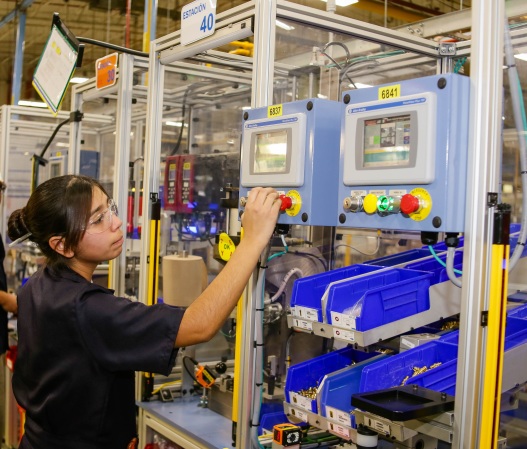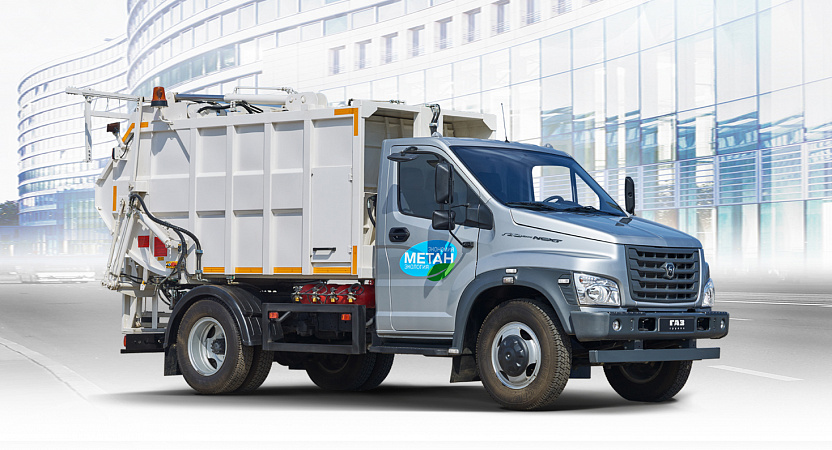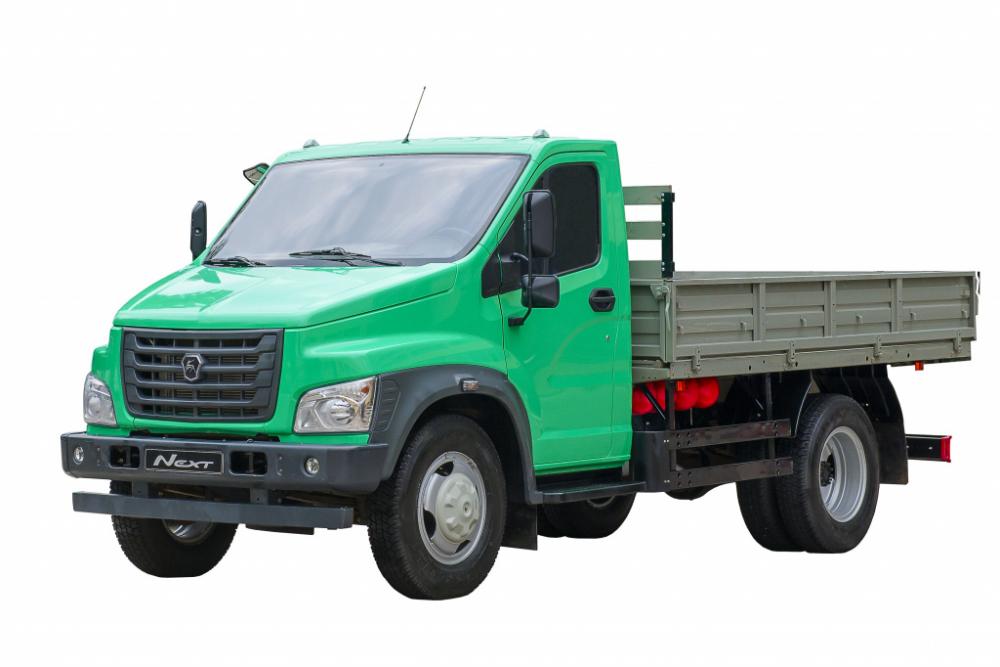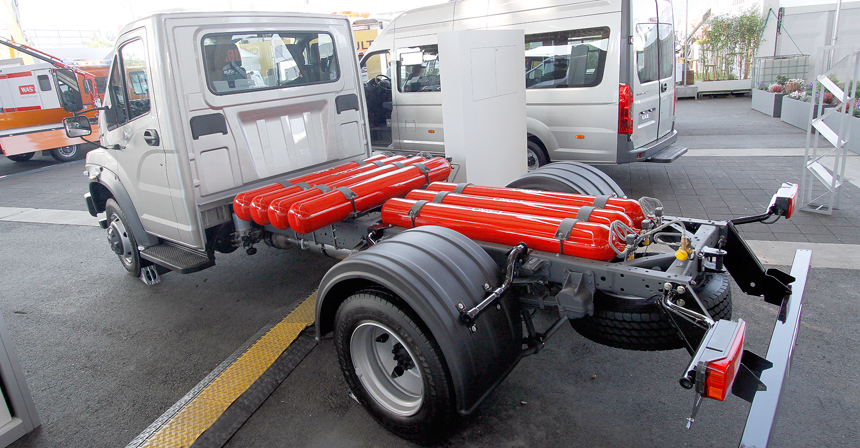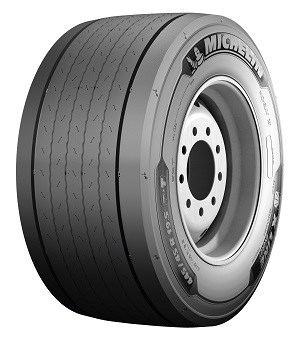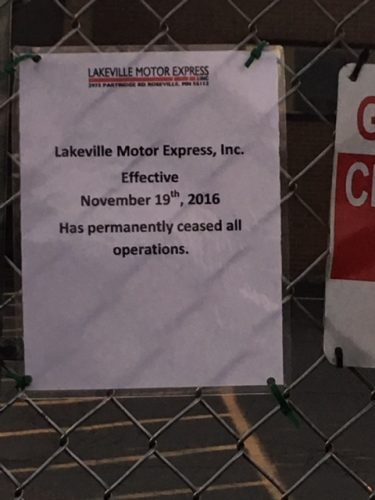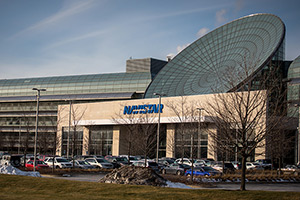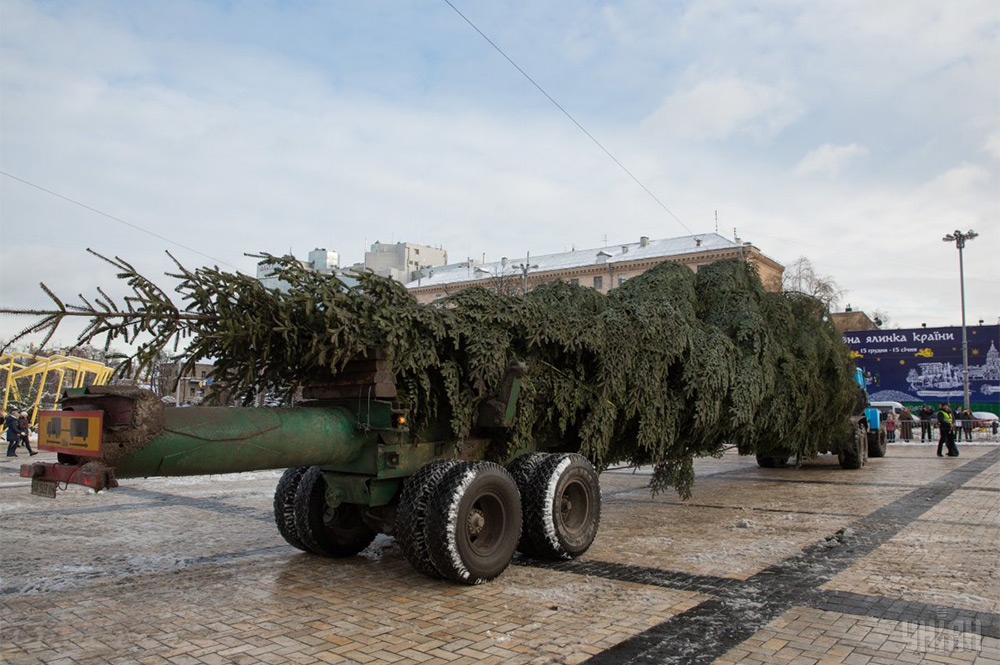
kscarbel2
Moderator-
Posts
18,935 -
Joined
-
Days Won
114
Content Type
Profiles
Forums
Gallery
Events
Blogs
BMT Wiki
Collections
Store
Everything posted by kscarbel2
-
Did you confirm 4QH312P2 is the correct part number based on your truck's model and serial number, and the 1QH front axle arrangement? When you contacted Watt's Mack (provider of the BMT website) at 1-888-304-6225 for a 4QH312P2 knuckle, what did they say?
-
Today’s Trucking / December 13, 2016 [Former* American brake valve pioneer] Bendix Commercial Vehicle Systems is doubling production capacity of its manufacturing operation in Acuna, Mexico to support growing demand for its solenoid valves and assembled manifolds. * Bendix is now owned by Germany’s Knorr-Bremse. The US $1.5 million investment in 2015 and 2016 added a low-flow solenoid production line and a new manifold line, supporting custom orders and just-in-time deliveries. The 412,000-square-foot manufacturing operation employs about 1,400 people. Bendix solenoids emerged in the 1970s when the market first began looking to Antilock Brakes. More than 1 million SMS-9700 accessory solenoid valves and FCS-9700 fan clutch solenoid valves have been made in Acuna. PACCAR, Volvo, Mack, and Daimler Trucks North America currently use Bendix solenoid valves. “Modern solenoids are capable of managing more than a dozen pneumatic accessories – we’re talking fifth wheel slide locks, lift axles, air horns, and wheel differential locks, in addition to others,” said Rebecca Carter, Bendix product manager – specialty valves. “Fleets and original equipment manufacturers are looking to Bendix for custom, advanced, low-flow solenoid solutions to meet a practically limitless range of vehicle needs, and these new lines in Acuna enable us to meet a growing demand with increased flexibility.” This year, the company expanded the manifold production area, where individual solenoids are combined into the manifolds that manage air accessories. “With these additions, Bendix can now produce nearly 1.2 million individual solenoids annually, and more than 350,000 manifolds,” Carter said. “We have essentially doubled our solenoid and manifold operations across the board in terms of manufacturing floor space, equipment, and employees, with no sacrifice to the performance and reliability that our customers expect Bendix to deliver.” .
-
Rex W. Tillerson Post: Secretary of State Previous experience: None Current position: Chairman and CEO of Exxon Mobile Corp. Age: 64 (Born March 23, 1952) Schooling: In 1970, Tillerson graduated from Huntsville High School in Huntsville, Texas. He earned a Bachelor of Arts (BA) degree in civil engineering from the University of Texas at Austin in 1975. Background: Tillerson was born on March 23, 1952, in Wichita Falls, Texas. Active in the Boy Scouts of America for most of his life, he earned the rank of Eagle Scout in 1965. He is married with four children, and lives in Irving, Texas. Tillerson joined Exxon in 1975 as a production engineer. In 1989, Tillerson became general manager of the central production division of Exxon USA. In 1995, he became President of Exxon Yemen Inc. and Esso Exploration and Production Khorat Inc.[13] In 1998, Tillerson became a vice president of Exxon Ventures (CIS) and president of Exxon Neftegas Limited with responsibility for Exxon's holdings in Russia and the Caspian Sea. In 1999, with the merger of Exxon and Mobil, he was named executive vice president of ExxonMobil Development Company. In 2004, Tillerson became president and director of ExxonMobil. On January 1, 2006, he was elected chairman and CEO, following the retirement of Lee Raymond. Tillerson has close ties with Russian President Vladimir Putin. They have been associates since Tillerson represented Exxon’s interests in Russia during President Boris Yeltsin's premiership. Tillerson has had more interactive time with Vladimir Putin than probably any other American, with the exception of Henry Kissinger. Tillerson is a friend of Igor Sechin, who is "widely believed to be Russia's second-most powerful person" after President Putin. In 2011, on behalf of ExxonMobil, Tillerson signed an agreement with Russia for drilling in the Arctic that could be valued up to $300 billion. Exxon began drilling in the Kara Sea in the Summer of 2014, and a round of sanctions against Russia introduced in September that year due to the Ukrainian crisis was to have brought the project to a halt in mid-September. Nevertheless, the U.S. government granted Exxon a reprieve allowing it to continue work until October 10, which enabled it to discover a major field with about 750 million barrels of new oil for Russia. In 2011, Tillerson, on behalf of ExxonMobil, signed a deal to develop oil fields in the autonomous region of Iraqi Kurdistan. The agreement was in defiance of Iraqi law, which forbids companies from dealing directly with Iraqi Kurdistan. In 2013, Tillerson was awarded the Order of Friendship by Russian President Vladimir Putin. In 2012, Tillerson's compensation package was $40.5 million. It was $28.1 million in 2013, $33.1 million in 2014, and $27.2 million in 2015. ------------------------------------------------------------------------------------ "Rex Tillerson's career is the embodiment of the American dream," Trump said. "His tenacity, broad experience and deep understanding of geopolitics make him an excellent choice for secretary of state." Tillerson said he was "honored" by the nomination, adding that he shared Trump's "vision for restoring the credibility of the United States' foreign relations and advancing our country's national security". "Rex Tillerson is an excellent choice for secretary of state. He will bring to the post remarkable and broad international experience; a deep understanding of the global economy; and a belief in America's special role in the world," Condoleezza Rice said. "I know Rex as a successful businessman and a patriot. He will represent the interests and the values of the United States with resolve and commitment. And he will lead the exceptional men and women of the State Department with respect and dedication." "I strongly endorse the President-elect's selection of Rex Tillerson to be the next secretary of state. He would bring to the position vast knowledge, experience and success in dealing with dozens of governments and leaders in every corner of the world," said former defense secretary Robert Gates. "He is a person of great integrity whose only goal in office would be to protect and advance the interests of the United States." Note: Gates and Rice were both critical of Trump during the election. Gates said Trump was "beyond repair" and "unfit to be commander-in-chief." Rice called for Trump to leave the presidential race in October, as he became mired in sexual assault allegations. "Rex Tillerson, who is a friend of mine, is an excellent choice to head the State Department and has an opportunity to be a very effective secretary of state,"said James Baker, secretary of state under President George Bush,. "As CEO of one of the world's largest and best-run companies, has demonstrated the management and negotiating skills, and has the international experience, that are required in the job." Baker's firm, Baker Botts, has aextensive ExxonMobil ties. It has represented Exxon on cases involving allegations of natural-gas price fixing and issues related to gas pipeline rates. It also represented Russian state-owned oil company Rosneft on a deal with Exxon. ------------------------------------------------------------------------------------ Political views Opposition to sanctions Tillerson has stated that "We do not support sanctions, generally, because we don't find them to be effective unless they are very well implemented comprehensively and that's a very hard thing to do." Climate change and carbon taxing In 2010, Tillerson said that while he acknowledged that humans were affecting the climate through greenhouse gas emissions to some degree, it was not yet clear "to what extent and therefore what can you do about it." Tillerson also stated, "The world is going to have to continue using fossil fuels, whether they like it or not." Tillerson stated in 2009 that he favors a carbon tax as "the most efficient means of reflecting the cost of carbon in all economic decisions—from investments made by companies to fuel their requirements to the product choices made by consumers." Support for the Trans-Pacific Partnership (TPP) In 2013, Tillerson outlined his support for the Trans-Pacific Partnership (TPP), stating at the Global Security Forum: "One of the most promising developments on this front is the ongoing effort for the Trans-Pacific Partnership... The 11 nations that have been working to lower trade barriers and end protectionist policies under this partnership are a diverse mix of developed and developing economies. But all of them understand the value of open markets to growth and progress for every nation.” Free Trade (Global Energy) Speaking in March 2007 at a Council on Foreign Relations event, Tillerson said: “Should the United States seek so-called energy independence in an elusive effort to insulate this country from the impact of world events on the economy, or should Americans pursue the path of international engagement, seeking ways to better compete within the global market for energy? Like the Council's founders, I believe we must choose the course of greater international engagement. ... The central reality is this: The global free market for energy provides the most effective means of achieving U.S. energy security by promoting resource development, enabling diversification, multiplying our supply channels, encouraging efficiency, and spurring innovation.” Government regulation In an interview with The Wall Street Journal, Tillerson expressed his impatience with government regulation, stating "there are a thousand ways you can be told 'no' in this country." Education In September 2013, Tillerson wrote an op-ed piece in The Wall Street Journal defending Common Core.[39] Fundraising and donations Tillerson is a longtime contributor to Republican campaigns. According to the FEC records available online, he has given $442,284.50 in direct contributions since 2003, $72,200 in "joint fundraising contributions" and $5000 to a Super PAC. FEC records do not show any contributions by Tillerson to Democrats during this period. He has contributed to the political campaigns of George W. Bush, Mitt Romney in 2012, and Mitch McConnell. He did not donate to Donald Trump's campaign, rather, Tillerson donated to Jeb Bush's campaign during the 2016 Republican primaries. Secretary of State consideration Rex Tillerson was first recommended to Trump for the Secretary of State role by Condoleezza Rice, during her meeting with Trump in late November. Rice's recommendation of Tillerson to Trump was backed up by Robert Gates, three days later. ------------------------------------------------------------------------------------ The New York Times / December 12, 2016 President-elect Donald Trump on Tuesday officially selected Rex W. Tillerson, the chief executive of Exxon Mobil, to be his secretary of state. In saying he will nominate Tillerson, the president-elect is dismissing bipartisan concerns that the globe-trotting leader of an energy giant has a too-cozy relationship with Russian president Vladimir V. Putin. The announcement brought to an end his public and chaotic deliberations over the nation’s top diplomat — a process that at times veered from rewarding Rudy Giuliani, one of his most loyal supporters, to musing about whether Mitt Romney, one of his most outspoken critics, might be forgiven. Instead, Trump has decided to risk what looks to be a bruising confirmation fight in the Senate. Republican and Democratic lawmakers had warned that Tillerson will face intense scrutiny over his two-decade relationship with Russia, which awarded him its Order of Friendship in 2013, and with Mr. Putin. The hearings will also put a focus on Exxon Mobil’s business dealings with Moscow. Exxon Mobil has billions of dollars in oil contracts that can go forward only if the United States lifts sanctions against Russia, and Tillerson’s stake in Russia’s energy industry could create a very blurry line between his interests as an oilman and his role as America’s leading diplomat. Tillerson has been publicly skeptical about the sanctions, which have halted some of Exxon Mobil’s biggest projects in Russia, including an agreement with the state oil company to explore and pump in Siberia that could be worth tens of billions of dollars. Senator John McCain, Republican of Arizona, said on Saturday that Mr. Tillerson’s connections to Mr. Putin were “a matter of concern to me” and promised to examine them closely if he were nominated. Under Tillerson, Exxon has entered into joint ventures with Rosneft, a Russian-backed oil company, and donated to the country’s health and social programs. Trump has fanned speculation about his choice for secretary of state for weeks. In the end, he discarded not only Giuliani and Romney, but also an endlessly changing list that at times included Tennessee Republican Senator Bob Corker; former Army general and C.I.A. director David H. Petraeus; and former Utah governor and 2012 presidential candidate Jon M. Huntsman Jr. [Huntsman Chemical]. Trump initially favored former New York Mayor Rudy Giuliani, but quickly grew weary of his penchant for drawing outsize media attention. Trump was also troubled by reports of Giuliani’s business entanglements overseas. And some of the president-elect’s closest advisers, including his son-in-law, Jared Kushner, saw Giuliani as a poor fit for the job. That led to interest in Romney, who had called Trump a “fraud” and a “phony” during the campaign. Trump and Romney made peace, meeting twice and speaking periodically by phone. But some of Trump’s advisers including campaign manager Kellyanne Conway warned that some of his supporters would quickly drift away if Romney were chosen. Tillerson emerged as a contender on the strong recommendations of James A. Baker III, the secretary of state under President George Bush, and Robert M. Gates, the former defense secretary. Kushner and Trump’s chief strategist, Stephen K. Bannon, argued strongly for Tillerson. Trump met with Tillerson on Saturday and described Tillerson as being in a different “league” than his other options. ------------------------------------------------------------------------------------ ------------------------------------------------------------------------------------ Associated Press / December 13, 2016 As Republicans in Washington bashed President Barack Obama's efforts to secure an Iran nuclear deal last year, Exxon Mobil was watching. The oil giant's European competitors were preparing to enter Iran's oil business - something the company legally could not do with American sanctions still in place stemming from Iran's nuclear program. Exxon hired lobbyists to monitor the fight in Washington, though the company said it never took a position on whether the sanctions were appropriate. Given CEO Rex Tillerson's position on sanctions in general, it was scarcely needed. "We always encourage the people who are making those decisions to consider the very broad collateral damage of who are they really harming with sanctions," Tillerson said at Exxon's 2014 shareholder meeting. Generally, "we don't find them to be effective," he said. Announced Tuesday as Donald Trump's choice for secretary of state, Tillerson has no deep history of diplomatic experience so it's unclear how he'll handle the job if confirmed. But he's not a blank slate. His work at Exxon has sometimes put him at odds with U.S. policy under Obama - and with key Republican positions on Iranian sanctions and Vladimir Putin's Russia. Trump has promised his "number one priority" will be to either rigidly enforce or dismantle the Iran nuclear accord and treat the country as "the biggest sponsor of terrorism" worldwide. But observers of Tillerson's business career say they expect his aversion to sanctions to stay in place. "He's a product of the Exxon system," said Fadel Gheit, an energy industry analyst for Oppenheimer & Co. Inc. "He believed in a free market. And if you have a contract, you have to meet your obligation." As part of the Exxon approach, the company adopted a strict policy that it deemed staying out of politics. If a government was stable - regardless whether it was corrupt - Exxon would work with it under strict contractual terms, said Gheit. "What Rex Tillerson says is 'that's none of my business,'" he said. That approach was crucial in Tillerson's dealings in Russia. Over the course of Tillerson's tenure there, Exxon succeeded where many of its rivals failed in working with Russia's government. Key among the company's choices was avoiding a partnership with Mikhail Khodorkovsky, an oil oligarch who went on to spend a decade in jail after challenging Putin. Tillerson helped Exxon broker a partnership with oil giant Rosneft to "be on the same side of the table" as the government. After Exxon struggled to work with local government officials, Putin told Exxon he would clear the way by executive order. Tillerson said no - on the grounds that Putin didn't have legal authority. Exxon would need laws changed. The demand initially infuriated Putin, but the project went ahead. The cordial relations continued after Tillerson ascended to Exxon's top job in 2006. When other oil companies saw relationships sour to the point that executives fled the country, Exxon continued to sign deals in Russia. Tillerson received an honorary medal - the Order of Friendship - from Putin's government in 2013. When Exxon Mobil ran into trouble in Russia in 2014, it came from Washington, not Moscow. As punishment for Russia's annexation of Crimea and support for pro-Russian Ukrainian rebels, the U.S. imposed sanctions. Exxon wasn't initially affected, and Tillerson said he didn't believe Russia would lash out at its American partner. "I think it's a very valued relationship by both parties," he said at a May 2014 Exxon shareholder meeting. As the crisis in Crimea deepened, however, the Obama administration extended sanctions to the Russian oil industry, hitting a partnership between Exxon and state-owned Rosneft to drill for oil in the Arctic. The sanctions - which Exxon lobbied against- cost the company as much as $1 billion. Though still bound by the prohibitions, Exxon executives have spoken of a desire to re-engage on the project. Should sanctions be lifted, Exxon and its stockholders would directly benefit - and Tillerson owns around $240 million in Exxon stock and options. Under federal conflict of interest rules, he will have to sell off his holdings if confirmed as secretary of state. Exxon has not always abided by America's diplomatic desires. In 2011, the U.S was trying to resolve a fight between Iraq's central government and a Kurdish regional government over oil money, a dispute that American diplomats saw as threatening Iraq's future as a single country. Negotiating in secret, Exxon struck a major oil deal directly with the Kurds. American officials were enraged. "I had to do what was best for my shareholders," Tillerson told the diplomats in a conference call explaining the company's move. The approach was emblematic of Exxon's culture and Tillerson's leadership.
-
Ryan Zinke Post: Secretary of the Interior Previous experience: None Current position: U.S. Representative for Montana's at-large congressional district Age: 55 (Born November 1, 1961) Schooling: Zinke has a Bachelor of Arts (BA) degree from the University of Oregon, a Master of Business Administration (MBA) degree from National University and a Master of Science degree from the University of San Diego. Background: Zinke was born in Bozeman, Montana, He is married and has three children. Zinke served as a U.S. Navy SEAL from 1986 to 2008, retiring at the rank of Commander. Zinke graduated from Basic Underwater Demolition/SEAL training class 136 in February 1986 and served with SEAL TEAM ONE from 1986 to 1988. He then was a First Phase Officer of BUD/S. Zinke served with United States Naval Special Warfare Development Group (NSWDG) from 1991 to 1993. He then served as a Plans officer for Commander in Chief, U.S. Naval Forces, Europe (CINCUSNAVEUR). Zinke served a second tour with NSWDG as team leader and operations officer from 1996 to 1999. From 1999 to 2001, Zinke served as executive officer (XO) for the Naval Special Warfare Unit Two. He was as executive officer, Naval Special Warfare Center from 2001 to 2004. In 2004, Zinke was deputy and acting commander of Combined Joint Special Operations Task Force–Arabian Peninsula, leading a force of more than 3,500 Special Operations personnel in Iraq. Zinke was awarded two Bronze Stars for meritorious service in a combat zone, four Meritorious Service Medals, two Joint Service Commendation Medals, two Defense Meritorious Service Medals, and an Army Commendation Medal. Following his tours in Iraq, Zinke was selected to establish the Naval Special Warfare Advanced Training Command, where he served as “Dean” of the Naval Special Warfare graduate school until his retirement from active duty in 2008. Zinke was elected to the Montana Senate in 2008, serving from 2009 to 2011, representing Whitefish, Montana. He was the running mate of Montana gubernatorial candidate Neil Livingstone in the 2012 election. The Livingstone/Zinke ticket finished fifth out of seven in the Republican primary with 12,038 votes (8.8% of the vote). In July 2016, Zinke withdrew as a delegate to the Republican nominating convention in protest of a plank in the party's draft platform which would require that "certain" public lands be transferred to state control. Zinke said that he endorses "better management of federal land", not transfer. In the spring of 2014, Zinke ram for Montana's at-large congressional district, a seat that became vacant when its then-incumbent Republican Steve Daines resigned in his successful U.S. Senate bid to replace Democratic U.S. Senator Max Baucus after he became the U.S. ambassador to China. Zinke won the five-way Republican primary with 43,766 votes (33.25%). Zinke campaigned on a message of North American energy independence, a stronger economy, and a robust national defense and border security. He won the general election with 56% of the vote out of over 200,000 votes cast in the statewide district. ----------------------------------------------------------------------------------------------------------- Trump interior secretary pick on climate change: 'I don’t believe it’s a hoax' The Guardian / January 18, 2017 Donald Trump’s nominee for secretary of interior, Ryan Zinke, distanced himself from president-elect Trump on Tuesday, saying “the climate is changing. The debate is what is that influence and what can we do.” Zinke, a two-term congressman for Montana, had been asked by Bernie Sanders about Trump’s infamous 2012 tweet where the real estate developer described climate change as “created by and for the Chinese in order to make U.S. manufacturing non-competitive”. Zinke, a former navy Seal, responded by stating matter of factly, “I don’t believe it’s a hoax.” The statement came in a hearing on his nomination held by the Senate energy and natural resources committee on Tuesday. However, the Trump cabinet nominee insisted he wasn’t “a climate science expert” and stated his belief in “being prudent” towards what he characterized as “a lot of debate on both sides of the aisle”. Zinke also differed from many in his own party by insisting: “I’m absolutely against transfer or sale of public lands.” Many Republicans have long pushed for the federal government to transfer ownership of public lands to the states, and this was included as a plank in the party’s platform. However, the Montana Republican still made clear his support for fossil fuel drilling on federal lands, saying “We have to have an economy.” Zinke is expected to sail through the Senate with bipartisan support. He was introduced by both of his state’s senators, Democrat Jon Tester and Republican Steve Daines, before the hearing on Tuesday. Zinke had long been considered the strongest general election opponent to Tester in 2018 but his appointment likely prevents him from seeking a Senate bid and boosts Democratic chances of holding onto Tester’s seat in the midterms. . .
-
As we head into the holiday season, I would like to warmly wish everyone a very Merry Christmas and a Happy New Year. As we used to say, “Mack means a lot of things to a lot of people”. BMT is much the same way. Without doubt, BMT is the best knowledge base for truck information the world over. There is no comparable medium that connects such a diverse group of truck people from around the globe. BMT has allowed us to form friendships not only with fellow Americans from coast to coast, but also with truly outstanding people worldwide, from Australia and New Zealand to Eastern and Western Europe. No forum has a finer, higher caliber group of members. I could spend hours writing about the many super people that make BMT so great and unparalleled. Lastly, I would like to warmly thank Barry once more for creating BMT, and his continued support.
- 8 replies
-
- 11
-

-
http://www.bigmacktrucks.com/topic/47138-egr-and-dpf-deletes-has-anyone-had-one-done/#comment-347732 http://www.bigmacktrucks.com/topic/46210-egrdpf-delete/#comment-340376
-
Prime Mover Magazine / December 12, 2016 Providing an incentive for fleets to carry out regular maintenance through a Fuel tax credit would help ensure vehicles meet emissions standards, the Australian Trucking Association (ATA) has suggested. Legislative change to the Fuel Tax Act's current maintenance and testing criteria would encourage more regular vehicle maintenance, said ATA Vice Chair Geoff Crouch. “Trucks need regular maintenance in order to meet emission standards and amending the eligibility for fuel tax credits would provide a powerful incentive for regular maintenance,” Crouch said. “Contained within the Fuel Tax Act are a set of environmental conditions that for trucking operators must meet to qualify for fuel tax credits. “A truck has to be manufactured on or after 1 January 1996, or meet one of three maintenance or testing criteria,” he said. When the Fuel Tax Act was first introduced, 61 per cent of the truck fleet was manufactured before 1996 and had to meet maintenance or testing criteria in order to claim fuel tax credits. In 2016 this has fallen to 33 per cent of the fleet. “The ATA supports the removal of the 1996 criteria, which would see the entire existing truck fleet needing to meet a maintenance or testing criteria in order to qualify for fuel tax credits,” Crouch said.
-
GAZ Group Press Release / December 12, 2016 The new GAZon NEXT CNG medium truck has entered into production. The truck is equipped with a state-of-the-art YAMZ-534 CNG powerplant meeting the latest global standards in power, torque, NVH (noise, vibration & harshness), emissions and fuel consumption. Production of the new YAMZ-534 CNG began at GG Yaroslavl Engine Plant on November 12, 2016. The application of compressed natural gas (CNG) reduces fuel costs by 40-50% as compared to the diesel version of the same engine resulting in significant operating efficiency gains. GAZon NEXT is a versatile multi-purpose medium truck designed for city and inter-city transport, vocational, utility and municipal operations. It combines high functionality, payload capacity, competitive price and low cost of ownership. Both standard and four-door "crew cab" configurations are available. With an 8.7 metric ton (19,180 lb) gross vehicle weight (GVW), the GAZon NEXT CNG can carry a 5 metric ton (11,023 lb) payload. The CNG version of the YAMZ-534 engine is rated at 149 horsepower at 2300 rpm, with a maximum torque of 490 Nm available from 1200 to 2100 rpm. Seven 72.8 m3 CNG bottles mounted under the body provide an operating range in excess of 370 kilometers (230 miles). The warranty for GAZon NEXT CNG, like the diesel version, is three years or 150,000 (93,206) kilometers. Related reading - http://www.bigmacktrucks.com/topic/47712-gaz-group-launches-cng-engine-range/#comment-352210 .
-
Gary Cohn Post: White House - Director of the National Economic Council Previous government experience: None Current position: President and COO of Goldman Sachs Age: 56 (Born August 27, 1960) Schooling: Cohn studied at Gilmour Academy, and received a Bachelor of Arts degree from American University's Kogod School of Business. Background: Investment banker Gary Cohn was born to an Eastern European family and raised in Shaker Heights, Ohio. Cohn is married and has three daughters. He lives in New York City. Cohn’s annual salary at Goldman Sachs was US$22 million in 2014. Cohn started his career at the home products division of U.S. Steel in Cleveland, Ohio. After only a few months at U.S. Steel, he left and started his career as an options dealer in the New York Mercantile Exchange. Cohn was recruited by Goldman Sachs in 1990. In 1996, Cohn was named head of Goldman Sach’s commodities department, part of Fixed Income, Currency and Commodities Division (FICC). In 2002, he was named head of the division. Since January 2004 Cohn was the co-head of global securities businesses and he was the co-head of Equities since 2003. Cohn was head of Goldman Sach’s global securities businesses from December 2003, and became President and Co-Chief Operating Officer, and director, in June 2006. Trump says Cohn will “put his talents as a highly successful businessman to work for the American people”. Trump was critical of Goldman Sachs during the presidential campaign and lambasted Democratic rival Hillary Clinton for giving paid speeches to the Wall Street giant. But Trump’s now chosen three people with ties to Goldman Sachs for his administration, including Steven Mnuchin, the Treasury secretary nominee, and Steve Bannon, Trump’s chief strategist and senior counselor.
-
HGVUK / December 12, 2016 Michelin has expanded its X Line Energy tyre range with the launch of six new sizes, enabling more truck fleets to benefit from its most fuel-efficient truck tyre generation’. Designed primarily for mega-volume trailers, car transporters and low height tractor units, the new additions are said to offer improved mileage, increased fuel efficiency and a lower rolling resistance compared to the previous generation of Michelin fuel-saving tyres in these sizes. The launch sees Michelin X-Line Energy multi-position tyres now available in 315/60R22.5, 295/60R22.5, and an all-new 355/50R22.5 size. Drive versions are offered in 315/60R22.5 and 295/60R22.5. The trailer range has been expanded with 445/45R19.5 fitments. All new sizes offer improved mileage potential over their predecessors, with the 315/60R22.5 and 295/60R22.5 all-position tyres projected by Michelin to offer 30 per cent and 17 per cent improved mileage potential, respectively. Michelin says the new sized will offer a fuel saving of 1.25 litres per 100km during the tyres’ first life – and up to 2.5 litres of fuel saved per 100km when the tyres are new. Guy Heywood, Commercial Director UK and Republic of Ireland at Michelin, says: “With fuel prices rising steadily, fleets are placing renewed focus on ensuring their vehicles are operating as efficiently as possible. The expansion of our X Line Energy range opens up a wealth of fuel-saving potential to more operators.” The new tyres’ efficiency is highlighted by their fuel efficiency rating under EU tyre labelling legislation. The new 315/60R22.5 all-position and 295/60R22.5 all-position tyres improve from a ‘C’ to a ‘B’ rating versus their predecessor, whilst the 315/60R22.5 drive and 295/60R22.5 drive tyres have improved from ‘D’ to ‘B’. The 445/45R19.5 trailer tyre has jumped from ‘C’ to ‘A’, whilst the all-new 355/50R22.5 all-position tyre has a ‘B’ rating. The new tyres are available on both the original equipment and replacement markets. For further information on the Michelin commercial vehicle tyre range visit http://trucks.michelin.co.uk/ .
-
Isuzu Commercial Truck of America Press Release / December 12, 2016 . . . . . .
-
Minnesota Trucking Company Padlocks Doors, Shutting Out 95 Workers
kscarbel2 replied to kscarbel2's topic in Trucking News
Teamsters allege carrier abruptly closed, then reopened under new name without notifying employees Commercial Carrier Journal (CCJ) / December 12, 2016 Following the sudden closure of a roughly 45-truck Minnesota-based carrier, the Teamsters Union has alleged the company reopened under a new name. The Teamsters have led protests against the new Finish Line Express. The union claims FLE siphoned resources and customers from Lakeville Motor Express. The Teamsters say the two are sister companies. In recent months, FLE has received LME’s management, trucks and equipment, the Teamsters allege. They also say numerous customers have told them an FLE truck has arrived after they called LME. Lakeville Motor Express employees found the gates locked when they arrived for work at the 95-year-old company in late November. Attached was a notice that stated, without elaboration, that the Roseville company “has permanently ceased all operations, effective Nov. 19.” Lt. Gov. Tina Smith condemned LME’s actions at a Dec. 2 rally held by the Teamsters, which represent 90 of its 95 employees. Earlier this fall, another regional LTL-carrier opened in Maple Grove after incorporating last May. The carriers have not responded to media inquiries after the (Minneapolis) Star-Tribune published the initial account Nov. 26. FLE Vice President Mike Sanford told the newspaper his company was not connected to LME’s closing. Sanford, who until recently was Lakeville’s VP, denied that the companies share ownership. That story also references a letter Teamsters received shortly after the shutdown from LME’s Kevin P. Deming, who blamed “heavy financial losses” for the closing. “Lakeville is out of cash and has no reserves to pay any amounts owed to employees or vendors at this time,” the Lakeside owner and CEO wrote. The union now is attempting to discourage customers from “continuing to utilize sister companies LME and FLE.” Members advocate asking clients if they “support the type of business practices used to hurt 95 families at Lakeville Motor Express?” They also have picketed FLE since the Lakeville shutdown. On Nov. 25, the National Labor Relations Board closed the company’s case against the Teamsters and accepted FLE’s request to withdraw the charge. A week earlier, the company had filed complaint with the board over union picketing. Lakeville is not protected under the federal Worker Adjustment and Retraining Notification Act. WARN requires companies with at least 100 employees to notify workers 60 days in advance of covered plant closings and mass layoffs. . -
Senate locks in restart rollback at deadline Fleet Owner / December 12, 2016 With less than hour to go before a midnight deadline, the U.S. Senate on Friday joined the House to enact a “fix” to the hours of service restart provision that restores the regulation to the pre-July 2013 version. Oh, and the vote also kept the government running. The annual funding bill for federal government, including the budget for the Dept. of Transportation, has been where Congress has blocked the restart since 2014, pending the completion of a DOT study on the real-world effectiveness of the 2013 HOS changes. The changes included requiring two overnight off-duty stretches between 1 a.m. and 5 a.m. to reset a truck driver’s workweek. Trucking has lobbied successfully for the suspension each year since, arguing that the change, in addition to disrupting the sleep schedules of some drivers, put more trucks on the road during the morning rush hour, increasing congestion and the risk of accidents. However, a drafting error in the language included in the 2016 funding bill left the HOS regulations in a potential legal limbo, prompting the need for the correction in the federal funding extension just passed. The correction also locks in the suspension, meaning it won’t have to be renewed each year until the study is complete. “It is now our hope that as an industry, we can put this issue firmly in the rearview mirror,” said American Trucking Assns. President and CEO Chris Spear. “Thanks to hard work by Congressional leaders of both parties and in both chambers, we are one step closer to having an hours-of-service restart rule that makes sense and puts safety first” The restart rollback has faced annual opposition, however. The Advocates for Highway & Auto Safety last week called the inclusion of the restart provision “a major assault on safety” that would “decimate” the HOS rule. “The House and Senate Republican leaders just delivered special trucking interests an early Christmas present,” said AHAS President Jackie Gillan. “Special interests succeeded in getting this rollback despite the growing problem of truck driver fatigue in the industry, unabated increases in truck crash deaths and injuries, and overwhelming public opposition. … It is simply unthinkable that any industry with such an abysmal safety record and responsible for so many innocent deaths and injuries could actually find so many willing partners in Congress to push their greedy anti-safety agenda.” And Sen. Cory Booker (D-NJ), who has led opposition to the rollback in the Senate, opened a forum on transportation security last week by echoing the AHAS position on truck crashes. Booker called on Congress “to work together” to address “one of the monumental areas in which people are dying in America.” Trucking, on the other hand, insists the 2013 HOS changes would increase the number of crashes involving commercial vehicles. “These rules, put forward based on a very limited laboratory sleep study, could have had serious negative safety impacts,” ATA’s Spear said. “The restart is an important tool for drivers, not to maximize driving time, but to have the flexibility to maximize off-duty time and time at home, and we are pleased that drivers will continue to have unrestricted access to it.” .
-
Sean Kilcarr, Fleet Owner / December 12, 2016 Body repair and paint technicians are one breed of truck technicians that’s getting harder to find, especially in the face of changing customer demands for such “specialized” disciplines. Dick Schmidt will tell you that 10 years ago, when a truck owner needed body repairs and/or paint work for their equipment, it had to be done with high quality – even if it meant taking extra time to do it. Nowadays, however, while the demand for quality remains the same, most truck owners want it done as fast and as cheap as possible – putting more pressure upon two technician disciplines that are already in short supply. “Because body filler and paint are so expensive these days, waste is a big concern – especially since truck customers want it fixed faster and cheaper so they can get their vehicle back on the road making money,” Schmidt, director of collision center operations for Rush Enterprises, told Fleet Owner here during the 2016 Rush Technician Skills Rodeo. “And it’s getting extremely hard if not harder to find these [body and paint] technicians compared to regular service techs,” he added. “It’s an almost old school [technician] discipline; it’s manual labor. Most young guys just don’t want to do this. They’d rather work with computers.” Schmidt said Rush operates some 26 collision repair facilities within its network of more than 100 dealerships; facilities spread out from “Los Angeles to Florida and Chicago down to McAllen, Texas,” he noted. The company employs some 250 to 300 body repair and paint technicians and five from each discipline – for a total of 10 technicians – are competing among the 165 semi-finalists at this year’s Rodeo, which is being held at the Henry B. Gonzalez Convention Center in downtown San Antonio. Complicating matters in the “real world” outside of the Rodeo are the cost pressures now being placed on truck body repair and painting services, Schmidt said – meaning technicians in those specialties must be able to work fast without sacrificing quality or overusing body filler and paint supplies, which drives up repair costs. For example, Marcy Fernandez, North American fleet manager for the commercial transportation segment at paint-maker Axalta, said some high-end truck paints can cost $3,500 a pint and with the large amount of surface area on a Class 8 truck to cover, overusing even a little bit can make the job unprofitable in a hurry. “It’s not like the automotive world, where paint is layered on coat by coat, which can help blend out imperfections,” he pointed out. “Because trucks are so big, we must take a ‘one-and-done’ approach – and applying one clean coat requires a [paint] technician to make the [paint] mixture just right and apply it with even-handed discipline.” Being forced to apply two coats due to a mistake can be a bottom-line buster, Fernandez added. “That turns a $1,400 job into a $3,000 job; you just can’t afford to use a quart or two extra anymore,” he stressed. “That’s why we also say there’s a little ‘magic’ needed when you are applying high-solid paints in one coat. Because if it is not done just right, you’ll see the imperfections.” John Spoto, national heavy duty commercial fleet manager for 3M, noted that the same pressures are being felt by body repair technicians, too. “For example, when you are repairing dents in this competition, we’re looking not just at the final appearance of the repair, but how much material did you use and whether you followed the proper procedures,” he emphasized. “Anyone can take a gallon of filler to repair a dent. But that is adding cost to the repair, and if there are lots of sanding scratches, it’ll require more paint to cover [the repair] as well.” Part of the problem, though, is that such “specialty” technicians as a group are older than the main population of truck technicians, said Spoto – averaging around 53 years in age. Thus he feels it will be doubly hard finding new entrants to this particular technician specialty because not only must they work primarily with their hands – something that’s becoming a “lost art” in the vocational schooling realm – but they must also bring a high degree of “mental focus” to the job as well. “Safety is the most important variable; you must make a repair that is safe and that will be durable,” Spoto stressed. “It is all about the will to improve yourself and the ability to apply your knowledge.” In many ways, he said the “mind must overcome the hands” in terms of learning for instance how much force to apply, or not to apply, when hammering out dents so as not to overstress the metal. Rush’s Schmidt added that body repair is becoming more complicated as more and different fiberglass and plastic materials are being used on trucks – just like what’s occurring in the automotive world – in lieu or steel and aluminum. “They are of better quality and more durable but as they [the OEMs] change the product, we need to change our repair and paint procedures,” he said. “What doesn’t change is the need for greater productivity, efficiency, and safety, while ensuring minimum waste of material.”
-
Wabash’s Aerodynamic Devices Reduce Drag by 30% on Navistar’s SuperTruck Trailer/Body Builders / December 12, 2016 Wabash National Corporation has released details about its trailer that was part of Navistar’s SuperTruck combination vehicle, including numerous aerodynamic trailer devices, three of which were based on the company’s commercially available Ventix DRS skirt, AeroFin XL tail device and nose fairing. The aerodynamic improvements reduced the trailer’s drag coefficient by more than 30 percent, according to Navistar. The U.S. Department of Energy’s SuperTruck program, a five-year research and development initiative, focused on improving freight efficiency (the amount of freight hauled per gallon of fuel used) by 50 percent compared to 2009 base model heavy-duty tractor-trailer vehicles. “Each of the trailer components selected for the SuperTruck combination vehicle were designed as concepts of what the next generation of aerodynamic devices will look like from Wabash National,” said Brian Bauman, vice president and general manager, Wabash Composites. “On the heels of the GHG2 rule being finalized, the industry will need to innovate in order to meet fuel efficiency standards in the future. The SuperTruck initiative allowed us to leverage our fleet-proven aerodynamic technologies and years of aerodynamic research and development to innovate with our customer in mind.” In addition to the aerodynamic device additions, Wabash National reduced the weight of the trailer by more than 2,000 pounds, compared to its 2009 dry van. All components used to reduce the weight of the trailer, such as wide-base single tires and a variety of aluminum componentry, are commercially available. Wabash National was part of Navistar’s SuperTruck team—one of four industry teams to participate in the SuperTruck program. Navistar unveiled its SuperTruck on September 28, reporting a 104 percent improvement in freight efficiency. The average tractor-trailer gets 6 miles per gallon; Navistar and Wabash National’s SuperTruck combination vehicle gets over 13 miles per gallon. According to the DOE’s Office of Science, approximately 20 percent of the SuperTruck efficiency improvements come from advances in the truck’s internal combustion engines, with further efficiency gains attributed to improved aerodynamics, weight reduction, reduced rolling resistance with high-efficiency tires and specialty equipment that limits idle time.
-
Navistar opens truck reconditioning center outside Chicago
kscarbel2 replied to kscarbel2's topic in Trucking News
Navistar Locates Used Truck Reconditioning Center at Prototype and Testing Facility Transport Topics / December 12, 2016 Navistar has reopened its Used Truck Reconditioning Center and co-located it at its prototype and testing facility in Melrose Park, Illinois. The move follows the closure and sale of its Indianapolis center. “One of the greatest advantages of a centralized reconditioning center is the ability to work hand-in-hand with the on-site product engineering and prototype team in order to fully understand product durability and use this knowledge to provide the highest level of service to our customers,” said Jeff Heichel, vice president, used truck operations. The center supports used truck activities by examining the Diamond Renewed reconditioning process to ensure a consistent product is available to all International dealers and Navistar’s own 15 Used Truck Sales Centers. Additional benefits of the center include the ability to handle large transactions in a timely fashion, ensure quality improvements and meet internal cost targets. It includes a wash bay, detailing and paint booth, welding room and a parts storage area. “We worked with the Local UAW to structure a competitive agreement which facilitated the work coming to Melrose,” said Kevin Turner, director of reconditioning operations. . -
Automotive News / December 12, 2016 Stocks balloon to 8-year high The stout sales discipline that's producing huge profits for General Motors has a troublesome side effect: GM's vehicle inventory has ballooned 28 percent since Aug. 1, to the highest level in nearly nine years. Crowded dealership lots could force the automaker to make more production cuts -- beyond the layoffs of 2,000 workers in Michigan and Ohio announced last month -- if demand slips in 2017. Heading into the slower winter season, the situation shapes up as a critical test of GM's determination to resist profit-eroding incentives and fleet deliveries as relief valves. It also reveals a stark contrast between GM's rosy outlook for the industry and the pessimism at Ford Motor Co., which has reduced output this fall with downtime at many of its North American plants. While Ford warns of threats to its financial goals and reduces inventory to prepare for a slowdown, GM's production and inventory keep climbing. GM's inventory as of Dec. 1, 873,200 vehicles, is the highest of any month since February 2008, when it had four more brands to support and less-flexible union contracts that made it tougher to adjust production as consumer demand rose and fell. "Incentives are elevated, residuals are declining, and rates are rising," Brian Johnson, an analyst with Barclays Capital, wrote in a Dec. 2 note to clients. "And while GM in particular may benefit in the months ahead from new product launches, it's important to recognize that GM's inventory is elevated at the moment, and it wouldn't surprise us if they need to announce another production cut -- which could pressure the stock." Camaros galore GM officials acknowledge that the company has more inventory of some vehicles than it wants. In November it said plants in Lordstown, Ohio, and Lansing, Mich., where workers build the Chevrolet Cruze and Camaro and two Cadillac sedans, would lose their overnight production shifts in January. The move amounts to GM's first significant layoffs since 2010, when the company was streamlining operations after bankruptcy. As of Dec. 1, GM had a 177-day supply of the Camaro and about 120 days' worth of the three other affected nameplates. Average for the industry was 73 days, more than the 60-day supply that executives and analysts say is ideal. On those vehicles, "we have an oversupply -- there's no question about it," said GM spokesman Jim Cain. "We're going to be living with high days supply of those vehicles until the shift change can work its way through the system." Cain wouldn't rule out additional production cuts, but he disputed any notion that the excess would revive the destructive habits of Old GM. He said GM is strategically stockpiling crossovers ahead of impending redesigns and can't keep up with demand in some segments, including midsize pickups and large SUVs. New products "We're pretty optimistic that we're going to continue growing retail share and the industry is going to stay near these record levels," Cain said. "Carrying higher inventory is actually good business. We feel like we've got a real opportunity to keep improving our results." GM told analysts Oct. 25 that it was increasing production "marginally" in the fourth quarter. It no longer reports North American output publicly, but Automotive News estimates that GM produced 14 percent more vehicles in October than a year earlier and 18 percent more in November. "What's really driven the increase is filling out inventory on newly launched products and new entries that we didn't have before, like the [Cadillac] CT6 or the [Buick] Envision as an example," GM CFO Chuck Stevens said in an Oct. 25 conference call with analysts. "Our inventory levels will be dictated by matching supply with demand. We will continue to watch inventories closely, especially cars, and will take actions if and when required." Ford, on the other hand, after building 10 percent more vehicles in the first half of the year, produced 12 percent fewer from July through November as its forecast shifted. Ford CEO Mark Fields has said the company is merely being proactive and realistic to keep itself out of trouble. "It's still a very healthy industry by historical standards," Fields told Automotive News in October, "but there are stresses in it, and we're getting ahead of that. 4-month spike Ford started 2016 with more inventory than GM despite having fewer nameplates and lower market share, but GM entered December with about 224,000 more vehicles in stock than Ford, the biggest disparity between the two automakers in four years, according to the Automotive News Data Center. Until 2007, GM regularly carried inventory of more than 1 million vehicles, given that it had to pay workers at idled plants almost as much as when the assembly lines were running. A deal tied to its federal bailout in 2009 eliminated the Jobs Bank, and that change, combined with the permanent closure of some plants, cut inventory to fewer than 400,000 vehicles later that year. After rising with the industry's recovery, GM's stockpile declined gradually from early 2014 through the end of last year, before beginning to spike in August. The 28 percent gain since then is the company's largest four-month jump in inventory since the aftermath of GM's wildly popular employee-pricing discounts in 2005.
-
Automotive News / December 12, 2016 Grand Wagoneer, redesigned Ram heavy-duty pickup delayed Fiat Chrysler dealers will have to wait a bit longer for two highly anticipated big-ticket vehicles: a fully redesigned Ram heavy-duty pickup and a luxury SUV for Jeep, the Grand Wagoneer. Sources told Automotive News that FCA's Ram brand will not redesign its current heavy-duty pickups onto its new DT pickup platform in 2018 but instead will keep the same body-in-white and refresh the existing DS-based model. Meanwhile, the automaker has placed a hold on its development of the Jeep Grand Wagoneer luxury SUV, supplier sources say. The vehicle has been on Jeep's product plan since 2014 and was to boast three rows of seats and a six-figure price tag. It is unknown why these actions on important products for FCA's two most profitable brands are taking place; FCA has refused to comment. The automaker is in a financial race to erase nearly $7 billion in net debt that was on its books at the end of the third quarter. CEO Sergio Marchionne has said he plans to retire in 2018 and wants to leave the global automaker generating billions of dollars in free cash flow annually. To do that, the company is, in part, undergoing a major revamp of its North American manufacturing footprint in order to build more Jeep and Ram SUVs and pickups and fewer slow-selling sedans. It has also spent billions of dollars to resurrect the Alfa Romeo premium sport brand, introducing a new Giulia sedan and Stelvio crossover, neither of which is on sale yet in the U.S. Through the first nine months of 2016, FCA said it had generated $1.49 billion in global profits. Saving cash Delaying or abandoning its plan for what FCA called in 2014 a "major update" of its heavy-duty Ram 2500 and 3500 pickups in 2018 will save FCA money on a changeover of its heavy-duty pickup plant in Saltillo, Mexico. Saltillo is FCA's only heavy-duty pickup factory, so keeping the current truck going with only a freshening will also ensure that Ram heavy-duty pickups remain available to dealers in an uninterrupted supply. But the delay will also leave the Ram 2500s and 3500s with a significantly older design than their heavy-duty competitors from top rivals Ford and General Motors. Ford, for example, just redesigned its heavy-duty pickups this year, boasting improved towing capabilities and better fuel economy. In its five-year business plan presented in May 2014, Ram had forecast what it called a "major update" for its heavy-duty pickups and chassis cabs in 2018. FCA has since dramatically altered its business strategy, abandoning U.S. production of low-profit cars to focus primarily on building more pickups and SUVs, taking advantage of sweeping changes in consumer preferences. The DS-based Ram 2500 and 3500 pickups were first introduced in 2010. They have been refreshed to various degrees in the intervening years, expanding their capabilities amid a customer base that is about 75 percent commercial, according to the brand's 2014 business plan. FCA reports combined sales of light-duty and heavy-duty Ram pickups each month, and said in 2014 that about a quarter of the brand's pickup sales are heavy-duty models. Through November, Ram pickup sales are up 8.1 percent. '$140,000 Jeep' The development hold on the Jeep Grand Wagoneer is surprising in part because FCA executives have been unusually forthcoming about the vehicle compared with the company's usual practice of refusing to comment on future product plans. In late June, Jeep brand head Mike Manley told reporters that the Grand Wagoneer would push the premium boundaries of the SUV brand. He elaborated at the Paris auto show, telling reporters that pushing the Grand Wagoneer "up to $130,000 to $140,000 may be possible." The Grand Wagoneer was initially scheduled to be launched in 2018 but was pushed back last year to 2019 so the vehicle could be co-developed with the next-generation Jeep Grand Cherokee, Marchionne said last year. The key to the Grand Wagoneer's most recent delay may lay in the constraints FCA is under with its North American manufacturing plants and the company's ongoing product shift away from passenger vehicles. During its negotiations with the UAW in 2015, FCA unveiled a product plan that called for the unibody Grand Wagoneer to be built at the company's Warren Truck Assembly plant, after that plant's product, the Ram 1500 pickup, was redesigned and moved to the nearby Sterling Heights Assembly plant. But building the Grand Wagoneer at Warren would require the plant to be completely retooled from body-on-frame assembly to unibody assembly. That's a large added expense for an automaker already paying to retool two unibody assembly lines at Sterling Heights and in Toledo, Ohio, in 2017 to body-on-frame production. FCA already builds a three-row crossover -- the Dodge Durango -- off of the current Jeep Grand Cherokee platform at its Jefferson North Assembly plant in Detroit. That plant's capacity is already maxed out, however, meaning FCA could not easily add another product there without incurring major expenses or disruptive production changes. Prior to being run by Fiat, Jeep produced a three-row, high-end SUV off of the Grand Cherokee platform, the Jeep Commander. It did not sell well, suffering in part because its third-row seating lacked sufficient legroom. Marchionne hated the Commander as well, telling reporters in 2011: "That car was unfit for human consumption. We sold some, but I don't know why people bought them."
-
-
-
KrAZ Delivers National Christmas Tree to Ukraine’s Capital
kscarbel2 posted a topic in Trucking News
KrAZ Trucks / December 5, 2016 The Christmas and New Year holidays are on the horizon and everybody young and old are waiting for their favorite winter holiday. Contributing to the occasion, a new KrAZ model 6446 all-wheel-drive tractor, popular with Ukraine’s logging industry, was chosen to retrieve an 86-year-old 26-meter-tall fir tree from the Ivano-Frankovsk region for public display in the center of Sofiyskaya Square in Kiev where holiday celebrations will take place. A KrAZ-255B crane truck, the legendary predecessor to the 6446, supported the tree’s mounting. Few heavy trucks are capable of traveling deep into the forest to retrieve such a tree, but the 6x6 model 6446 was easily up to the task with its famous off road credentials. The 6446, with a gross combination weight rating of 34 metric tons both on and off road, excels in forestry applications. Very soon, the huge tree will be decorated with thousands of decorations made in Yavorov, and wrapped with 3 kilometers of lighting. The Christmas tree opening will take place on Monday, December 19, on the day of St. Nicholas. . -
Hino Trucks Press Release / November 25, 2016 “We will be aiming to win our 8th straight championship in our class with a 1-2 finish, and to join the group of leading finishers in the overall trucks category.” Team holds event announcing entry in Dakar Rally 2017. .
-
- 1
-

-
Owner/Driver / December 9, 2016 The best photos and coverage from Victoria's Castlemaine Truck Show held in November The 2016 Castlemaine Truck Show proved once again why it is the premier Victorian truck show. Held at the Campbell Creek recreation reserve on November 19-20, the show attracted a wide variety of trucks from brand new trucks, customised trucks, working trucks and vintage trucks. One of the beauties of the show is its laid back atmosphere with many arriving on Friday afternoon and setting up camp for the weekend. It’s a friendly and welcoming crowd with many regulars attending year after year. The Rotary Club has now held 28 truck shows and together with other local service clubs and organisations provided everything that is needed for a great weekend. The winner of the Rig of the Day on Saturday was Troy McLean with his Kenworth T908. Sunday is the big day commencing with a truckies’ breakfast and then the convoy through Castlemaine. The main street is lined with residents and the sounds of truck horns can be heard all over the district. As crowd numbers grew, so did the intense heat when the sun came out, thankfully there were some cloudy patches during the day. There were raffles over both days with a bar fridge on offer and an auction on Sunday afternoon. The standard of presentation of trucks was excellent and as Castlemaine is known as a truck town, the American marquees had new trucks on display. The winner of Truck of the Show was Leo Kelly and his impeccably restored W model Kenworth. Once again Castlemaine put on a top show, it’s a big effort but the rewards are great with Rotary using the raised $9,965 to assist with valuable community causes. Photo gallery - https://www.ownerdriver.com.au/events-news/1612/castlemaine-truck-show-2016
BigMackTrucks.com
BigMackTrucks.com is a support forum for antique, classic and modern Mack Trucks! The forum is owned and maintained by Watt's Truck Center, Inc. an independent, full service Mack dealer. The forums are not affiliated with Mack Trucks, Inc.
Our Vendors and Advertisers
Thank you for your support!


